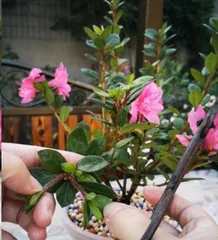Rhododendron, with its picturesque beauty, always makes one want to get close. To make this flower bloom in its most beautiful form in your garden, pruning is a crucial step! Today, let me take you into the world of rhododendron pruning, allowing you to easily master pruning techniques and let your rhododendron bloom with an even more charming grace!
I. Choosing the Right Time for Pruning
To prune correctly, you first need to know the best time for it. Generally, the period right after the spring flowers have bloomed is the golden time for pruning rhododendrons. At this time, the flowers have withered, and new buds are about to sprout. Pruning can promote the growth of these new buds and make the plant healthier.
Of course, you should also avoid pruning in the fall. Because pruning in autumn might affect the formation of flower buds for the following year, leading to fewer flowers. So, be very cautious when pruning in the fall!
II. Preparing Your Pruning Tools
A workman must sharpen his tools if he is to do his work well. For pruning rhododendrons, a sharp, clean pair of scissors or pruning shears is essential. Additionally, to prevent the spread of disease, it's best to disinfect your shears with a disinfectant solution before you start.
III. Detailed Pruning Steps
1. Remove withered flowers: First, cut off all the withered flowers along with their flower stems. This process is also known as "deadheading" and helps to promote new growth.
2. Prune weak branches: Carefully observe the plant and completely remove any branches that look diseased or dead, cutting back to the healthy wood.
3. Shaping and pruning: Adjust the shape of the plant as needed by removing crossing branches, competing branches, and overly dense clusters. This improves air circulation and allows sunlight to reach the interior of the plant.
4. Controlling size: If you want to control the overall size of the rhododendron, you can moderately prune the longer branches, but do not remove more than one-third of the entire plant at once to avoid affecting next year's bloom.
IV. Post-Pruning CareAfter pruning is complete, provide the plant with plenty of water and appropriate fertilizer to help it recover. Also, regularly check for any signs of pests or diseases and take action if needed.
V. Pruning Tips to Share1. Prune moderately: When pruning, do so moderately and avoid over-pruning. Especially for beginners, try to prune minimally to avoid affecting flowering the following year.
2. Understand the variety's characteristics: Before you prune anything, make sure you understand the characteristics of the rhododendron variety you are growing, as different types may have different pruning needs.
3. Prune gradually over the years: For large or aging rhododendron bushes, it's recommended to prune them gradually over several years rather than making a drastic change to their shape all at once.
4. Keep the environment clean: Regularly clean up fallen leaves and other plant debris to keep the area around the plant clean, which helps reduce the likelihood of pests and diseases.
With these detailed steps and tips, I believe you now have a deeper understanding of how to prune rhododendrons. Now, let's get to work together to create a more beautiful and healthy home for your rhododendrons! I am sure that in the near future, your garden will be filled with even more splendid rhododendrons!